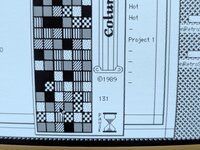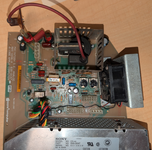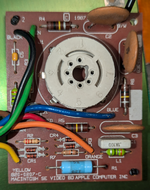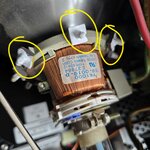I'm new to this forum, and fairly new to some aspects of vintage computer repair even though I've used 'em since they weren't vintage. I've dug through these forums and others but not seen an issue quite like the one I'm dealing with.
I've got an SE/30 that, until this past year, I didn't even know worked - I was given it along with several other partial compact Macs by a friend years ago, and they sat in a shed that wasn't terribly watertight, so when I dug them out for a project, there was plenty of surface rust, and the mainboard was a bit crusty looking, but fortunately not battery bombed. After a reasonable cleaning, and wiggling the ROM SIMM a bit, it came to life, and it's got an external video card in it, even!
In the process of making it more presentable, I've swapped the analog board for a spare from an SE that had a good flyback transformer, recapped THAT board, the power supply and the mainboard with kits from Console5, put a new battery in and replaced the HDD (which I managed to get working enough to back up) with a BlueSCSI. It now boots (and chimes) and runs reliably, and for the most part, looks great.
Except there's noise in the video that gets stronger as it warms up - after about ten minutes, it reaches a peak and stays there. I saw it surge with HDD activity while I was working on recovering the files that came with it, but that part isn't in the machine. I've tried replacing the HOT and reflowed the analog and CRT boards, but am unsure where to look next. The caps on the mainboard leaked at least a little, at least judging by how they looked when I removed the old ones, but I don't see much of anything that looks like corrosion beyond all the solder on the board being dull and slightly soft (fuzzy?) looking - no green crud. All of the pads came clean easily and everything looked good to my eyes otherwise. I swapped the CRT board with the one from the SE, and the noise changed a bit but didn't go away. The only consistent thing I can to to reduce the noise is to turn down the brightness - the brighter it is, the stronger the noise is. The pictures attached show this at normal brightness (the noise moves randomly like static) and one turned almost to nothing, edited to be more visible. I also haven't seen any rogue solder or bridged connections, though it's always possible that I missed one.
Would the CRT board be the next thing to investigate, or should I still be looking at the motherboard or somewhere else? I've always been good to hang parts, and now I feel more confident I can solder them, but circuit-level diagnosis is still kinda new to me.


I've got an SE/30 that, until this past year, I didn't even know worked - I was given it along with several other partial compact Macs by a friend years ago, and they sat in a shed that wasn't terribly watertight, so when I dug them out for a project, there was plenty of surface rust, and the mainboard was a bit crusty looking, but fortunately not battery bombed. After a reasonable cleaning, and wiggling the ROM SIMM a bit, it came to life, and it's got an external video card in it, even!
In the process of making it more presentable, I've swapped the analog board for a spare from an SE that had a good flyback transformer, recapped THAT board, the power supply and the mainboard with kits from Console5, put a new battery in and replaced the HDD (which I managed to get working enough to back up) with a BlueSCSI. It now boots (and chimes) and runs reliably, and for the most part, looks great.
Except there's noise in the video that gets stronger as it warms up - after about ten minutes, it reaches a peak and stays there. I saw it surge with HDD activity while I was working on recovering the files that came with it, but that part isn't in the machine. I've tried replacing the HOT and reflowed the analog and CRT boards, but am unsure where to look next. The caps on the mainboard leaked at least a little, at least judging by how they looked when I removed the old ones, but I don't see much of anything that looks like corrosion beyond all the solder on the board being dull and slightly soft (fuzzy?) looking - no green crud. All of the pads came clean easily and everything looked good to my eyes otherwise. I swapped the CRT board with the one from the SE, and the noise changed a bit but didn't go away. The only consistent thing I can to to reduce the noise is to turn down the brightness - the brighter it is, the stronger the noise is. The pictures attached show this at normal brightness (the noise moves randomly like static) and one turned almost to nothing, edited to be more visible. I also haven't seen any rogue solder or bridged connections, though it's always possible that I missed one.
Would the CRT board be the next thing to investigate, or should I still be looking at the motherboard or somewhere else? I've always been good to hang parts, and now I feel more confident I can solder them, but circuit-level diagnosis is still kinda new to me.





